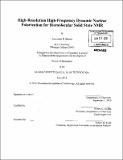| dc.contributor.advisor | Robert G. Griffin. | en_US |
| dc.contributor.author | Barnes, Alexander B. (Alexander Benjamin) | en_US |
| dc.contributor.other | Massachusetts Institute of Technology. Dept. of Chemistry. | en_US |
| dc.date.accessioned | 2011-08-18T19:10:28Z | |
| dc.date.available | 2011-08-18T19:10:28Z | |
| dc.date.copyright | 2010 | en_US |
| dc.date.issued | 2011 | en_US |
| dc.identifier.uri | http://hdl.handle.net/1721.1/65263 | |
| dc.description | Thesis (Ph. D.)--Massachusetts Institute of Technology, Dept. of Chemistry, June 2011. | en_US |
| dc.description | Vita. Cataloged from PDF version of thesis. | en_US |
| dc.description | Includes bibliographical references. | en_US |
| dc.description.abstract | Dynamic Nuclear Polarization (DNP) has exploded in popularity over the last few years, finally realizing its potential to overcome the detrimental lack of sensitivity that has plagued performing NMR experiments. Applied to magic angle spinning (MAS) experiments, this renaissance of DNP has been primarily driven by the development of instrumentation; namely gyrotron oscillators as high-power stable microwave power sources and the NMR probes and associated equipment required to spin samples routinely below 100 Kelvin. The first three chapters of this thesis provide an overview of the theory, instrumentation, and applications of DNP. Chapter 1 introduces the magnetic resonance Hamiltonian with a focus on interactions that are necessary to control in order to obtain high-resolution DNP spectra. Chapters 2 and 3 are published reviews of DNP. Whereas Chapter 2 targets magnetic resonance spectroscopists, Chapter 3 is intended for an electric engineering audience. Both reviews are included as the associated depth and coverage of the topics are complementary and lead to a better understanding of DNP. The later chapters describe in detail advancements in probe, cryogenics, and gyrotron technology required to perform DNP MAS experiments, as well as the gains in sensitivity and resolution such instrumentation has permitted. Of particular importance is the development of a cryogenic sample ejection system that resulted in exquisite resolution of spectra recorded <100 K, both of crystalline peptide and the active site of membrane proteins. Such developments in instrumentation and demonstrations of resolution go towards overturning a long-held stance in the field that DNP would always suffer from broadened, unresolved spectra. Such techniques also allow us to investigate site specific dynamics of a crystalline peptide, the high resolution SSNMR structure of which is discussed in Chapter 3. DNP and the developed instrumentation is also leveraged to measure inter-atomic distances in the active site of a membrane protein with sub-angstrom precision. Chapters 7 describes the calculation of the microwave field strength across the sample in a MAS DNP probe and introduces strategies to increase it. Finally Chapter 8 introduces a major advance in the microwave source technology associated with DNP experiments. Detailed designs of a novel 250 GHz gyrotron oscillator are shown and experiments demonstrate a continuous broad 3 GHz bandwidth with >10 W across the band, which results in substantially improved DNP performance. | en_US |
| dc.description.statementofresponsibility | by Alexander B. Barnes. | en_US |
| dc.format.extent | 252 p. | en_US |
| dc.language.iso | eng | en_US |
| dc.publisher | Massachusetts Institute of Technology | en_US |
| dc.rights | M.I.T. theses are protected by
copyright. They may be viewed from this source for any purpose, but
reproduction or distribution in any format is prohibited without written
permission. See provided URL for inquiries about permission. | en_US |
| dc.rights.uri | http://dspace.mit.edu/handle/1721.1/7582 | en_US |
| dc.subject | Chemistry. | en_US |
| dc.title | High-resolution high-frequency dynamic nuclear polarization for biomolecular solid state NMR | en_US |
| dc.type | Thesis | en_US |
| dc.description.degree | Ph.D. | en_US |
| dc.contributor.department | Massachusetts Institute of Technology. Department of Chemistry | |
| dc.identifier.oclc | 743301805 | en_US |
